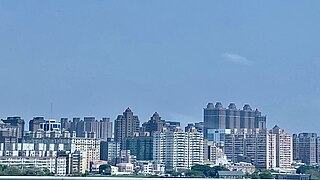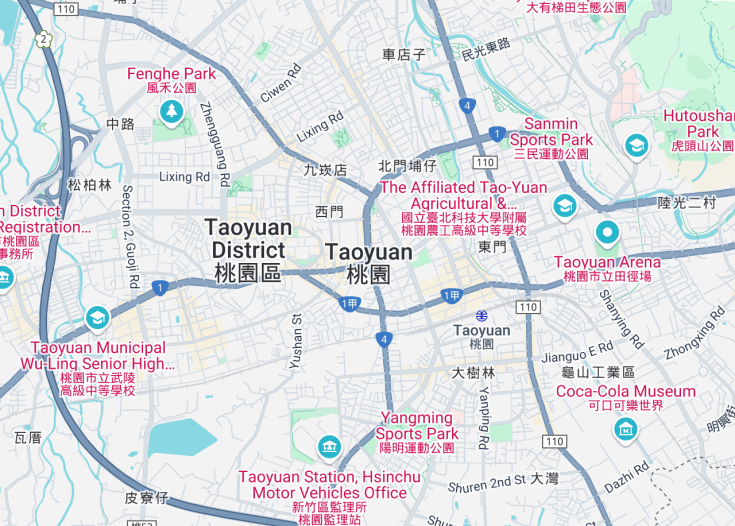Taoyuan, located in northern Taiwan, is a vibrant city known for its rich history, cultural diversity, and technological advancements. As a gateway to the island with Taiwan Taoyuan International Airport, it boasts lush landscapes and modern urban spaces.
Visitors can explore historic temples, sprawling night markets, and extensive green parks. Taoyuan’s blend of heritage and innovation offers a unique tapestry of experiences for all travelers.
Before visiting Taoyuan, consider exploring its lesser-known natural attractions such as Shimen Reservoir and the Xiao Wulai Skywalk for breathtaking scenic views.
For a deeper cultural understanding, plan your visit during local festivals like the Lantern Festival in February, providing rich insight into Taiwan’s traditions and community spirit.
Top things to do & see in Taoyuan
Select the following sights and activities to discover best tickets and tours available in Taoyuan.
Taoyuan: Gateway to Taiwan
| Country | Taiwan |
| Time in Taoyuan | GMT+8 |
| Language spoken | Mandarin |
| Population | 2,258,800 (source: Taoyuan Government, 2023) |
| Currency | New Taiwan Dollar (NT$, TWD) |
| Airports |
|
Taoyuan, located in the northwestern part of Taiwan, serves as an vital hub both economically and culturally within the region. Originally a part of Taipei County, it became an independent municipality and was later designated a special municipality in 2014, reflecting its rapid growth and strategic importance in Taiwan. It prides itself on its rich historical layers, being home to various indigenous peoples before massive Han Chinese immigration during the Qing Dynasty era.
Modern Taoyuan is noted for its diversity, with a dynamic mix of various ethnic groups, including a significant number of foreign workers and expatriates, contributing to its cosmopolitan vibe. This diversity is mirrored in its culinary scene, cultural festivals, and business landscape, particularly with its robust manufacturing and technology sectors. The city’s economy is bolstered by Taoyuan International Airport, Taiwan’s largest airport, playing a critical role in international trade and travel.
Moreover, Taoyuan boasts numerous parks, museums, and cultural sites, including the famous Daxi Old Street, Shimen Reservoir, and Yingge Ceramics Museum, which attract visitors for both their historical value and natural beauty. It also focuses on sustainability and has been recognized for its efforts in maintaining green spaces and promoting renewable energy practices.
The city’s commitment to public transport infrastructure, including ongoing extensions of Taipei Metro systems and upgrades to road and rail networks, exemplifies its role as a gateway city, not merely serving those looking to explore Taiwan but also those who stay to enjoy its vibrant quality of life.
Where is Taoyuan?
Located just 30 kilometers southwest of Taipei, Taoyuan is strategically placed as a hub in northern Taiwan.
Distances:
| Route | Distance by car | Time by car |
|---|---|---|
| Taipei to Taoyuan | 22 miles / 35 km | 45 minutes |
| Hsinchu to Taoyuan | 25 miles / 40 km | 50 minutes |
| Keelung to Taoyuan | 35 miles / 56 km | 1 hour 10 minutes |
What is Taoyuan famous for?
Taoyuan is renowned for its rich cultural tapestry, tech industries, and being the location of Taiwan’s main international airport, making it a crucial transportation hub.
History
Prehistoric to 17th Century
The region now known as Taoyuan has been inhabited by humans for thousands of years, with evidence suggesting the presence of prehistoric peoples in the area. The first recorded inhabitants were the indigenous Taiwanese tribes, who lived predominantly along the coastal areas and engaged in basic farming and fishing. During the 17th century, with the arrival of Dutch and Spanish settlers in Taiwan, Taoyuan became an area of strategic importance. The influx of Han Chinese settlers during the Qing Dynasty further shaped Taoyuan’s early demographics and cultural landscape.
18th Century to Japanese Rule (1895-1945)
The 18th and 19th centuries marked significant Han Chinese immigration under the Qing Dynasty, establishing the foundations of Taoyuan as a crucial agricultural center. This period saw the development of several settlements and the cultivation of key crops such as rice and tea. When Taiwan came under Japanese rule in 1895, Taoyuan underwent further transformation. The Japanese developed the area’s infrastructure, including railways and education systems, significantly modernizing the region. This era also saw the introduction of new agricultural practices and crops, further boosting the local economy.
Post-World War II Development
Following the end of World War II and the subsequent handover of Taiwan from Japan back to China, Taoyuan continued to grow as an industrial hub due to its strategic location and availability of flat, arable land. In the late 20th century, the region’s economy diversified from a primarily agricultural focus to include technology and manufacturing, spurred by Taiwan’s economic boom. The establishment of Taoyuan International Airport in 1979 positioned the city as an essential gateway to Taiwan and fueled urban development and population growth.
Visit Taoyuan
Attractions and Activities in Taoyuan
Explore the diverse attractions that Taoyuan has to offer. From historical sites to natural wonders, there is something for everyone. The city is home to the Cihu Mausoleum, the final resting place of Chiang Kai-shek, which is surrounded by beautiful landscapes and is a popular destination for history enthusiasts.
Nature lovers will appreciate the scenic Daxi Tea Plantation and the Shimen Reservoir, perfect for outdoor activities such as hiking and fishing. For a unique cultural experience, visit the Hakka culture preservation areas in Longtan, where you can learn about the rich heritage and traditions of the Hakka people. The city also boasts modern shopping districts and vibrant night markets, offering an array of local foods and crafts.
Festivals and Events in Taoyuan
Throughout the year, Taoyuan hosts a variety of cultural and recreational events that reflect the city’s rich heritage and dynamic community spirit. Key events include the Lantern Festival, which illuminates the city with elaborate displays and performances each February.
The Dragon Boat Festival, typically held in June, features exciting boat races and traditional rice dumplings. Another significant event is the Taoyuan Agriculture Expo, which showcases the region’s agricultural innovations and products, attracting visitors from across Taiwan and beyond.
Best time to visit Taoyuan
The ideal time to visit Taoyuan is during the spring (March to May) and fall (September to November) months. During these periods, the weather is generally mild, making it comfortable for exploring outdoor attractions and participating in local festivals. Additionally, these seasons offer the most pleasant natural scenery, perfect for photography and nature walks.
Is Taoyuan worth visiting?
Taoyuan is certainly worth a visit for those interested in a comprehensive experience of Taiwan’s cultural diversity, historical depth, and natural beauty. The city offers a mix of urban and rural charms, from bustling markets and modern malls to peaceful tea plantations and cultural preserves.
However, visitors should be aware of the potential for industrial areas to detract from the city’s aesthetic appeal and the congested traffic near the airport and major highways. Nevertheless, for those willing to explore its hidden gems, Taoyuan presents a rich tapestry of experiences that exemplify the vibrancy of Taiwan.










